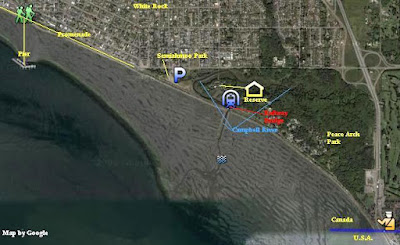
We decided last week to end that oversight.
We parked as close to the Semiahmoo Reserve as we could, found a trail through the rosebushes and blackberries, and crossed the tracks to the beach. The tide was low, but still going out. The pier, our usual eastward ending spot, was a good distance away.

Not much in the way of scenery, is there? Low hills, houses, flat sandy beach. It is more or less the same looking east.

We walked along the beach, zigging and zagging from shoreline to waterline, until we came to the outfall of the Little Campbell River. The water level was low; I read later that it is extremely variable.

River outlet on the right. A straight channel, here.
This "road", for such it seemed to be, made of smoothed gravel and outlined with barnacled posts, goes from the railroad bridge to ... nothing. The edge of the water. It does not extend beyond the railway; I think it is probably a retaining wall for the river, below the high tide level. Why it was made, I have no idea.
It was colder than we had expected; we turned back.
Ah, but I am missing out the most interesting part of the walk!
This was the most diverse beach I have seen in some time, in terms of the types of sand and the life we found on it. There is clean, sand-box sand, muddy sand, black, slimy sand, piles of brown, dead eel-grass or unidentifiable furry fibers, surf-smoothed stones, sharp-edged, clean gravel and barnacly gravel. Shallow pools may be dark green with eel-grass or yellowish with sea lettuce. A few areas support the invasive battillaria snails, although sometimes, bending to look at them, I found their shells mostly housing tiny hermit crabs. Yay, hermits!
The sand was sometimes ridged, sometimes smoothed by retreating water. In places the fecal castings of lugworms dotted the surface. In one area, every tiny valley was filled with what looked like those chocolate sprinkles they decorate cookies with.

Wave patterns on clean sand, with a few sprinkles.
Turning over rocks, I found some of those spunky crabs waving threatening pinchers at me. Another rock exposed a fistful of tiny shrimp. They squirmed and twisted in the light, but didn't dig themselves down into the sand, as the shrimp-like creatures on Boundary Bay beach do. Instead, they milled around within their little hollow like dancers on a stage. I put the rock back carefully once we had taken a couple of photos.


And, of course, we found shells. I brought home a couple of oyster shells, a tiny pink clam, and this one, that looked, sitting there in the sunshine, more like a butterfly than a clam.

A week ago, I had been wanting, for what I no longer remember, a bit of sand. Real sand, beach sand. On our way back to the car, I remembered, and collected a pill bottle full.
At home, spreading it out to dry, it occurred to me to look at it under my hand microscope. And that sand was alive! Everywhere I looked, it was squirming and bubbling. I saw tiny, transparent worms, gliding gracefully or waving to and fro. Something that jittered across my field of vision and disappeared. Tiny, tiny, shrimp-like animals. And a creature more like a barrel with streamers out the back.
I have no photos. I tried, stacking lenses over my tray of wet sand; all I got were bright points of light that were in a different position in the second of every pair of photos. And many tiny circles of deep red. In one photo, I can see -- almost -- what looks like segmentation in a red tube.
In the morning, I checked the tray again; something had raised little hills in the wet sand. Busy little beasties.
We covered barely a third of the Semiahmoo beach area; Laurie says we'll have to come back soon and look at the Ahmoo beach. Sometimes I wonder about him.

It looks like a nice area to wander and relax!
ReplyDelete